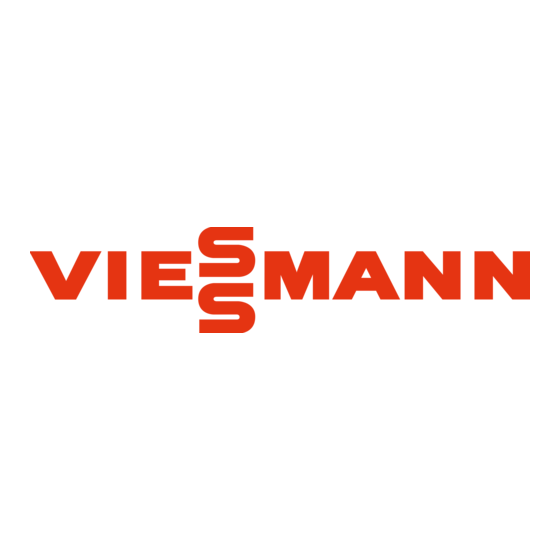

Viessmann VITOLADENS 300-T Installation Instructions Manual
Hide thumbs
Also See for VITOLADENS 300-T:
- Service instructions manual (24 pages) ,
- Service instructions for contractors (20 pages) ,
- Installation instructions manual (60 pages)
Summary of Contents for Viessmann VITOLADENS 300-T
-
Page 1: Installation Instructions
VIESMANN Installation instructions for contractors Vitoladens 300-T Type VW3B, 33 to 50 kW Oil Unit condensing boiler VITOLADENS 300-T Dispose after installation. 5729 533 GB 2/2011... -
Page 2: Safety Instructions
Safety instructions Please follow these safety instructions closely to prevent accidents and mate- rial losses. Safety instructions explained ■ all current safety regulations as defined by DIN, EN, DVGW, TRGI, Please note TRF, VDE and all locally applicable This symbol warns against the standards. -
Page 3: Table Of Contents
Index Preparing for installation................... Installation sequence Siting and levelling the boiler................■ Siting without DHW cylinder................■ Siting on a plinth....................■ Siting on a DHW cylinder.................. Fitting the thermal insulation................Preparing to install the heat exchanger..............11 Fitting the heat exchanger to the boiler..............12 ■... -
Page 4: Preparing For Installation
Preparing for installation Siting Clearance dimensions A Combustion chamber D Sensor well (only for Vitocell, B Boiler type EHA (350 l) C DHW cylinder Rated output... - Page 5 Preparing for installation (cont.) ≥ 250 A Plinth C Neutralising system B Siphon...
-
Page 6: Siting And Levelling The Boiler
Siting and levelling the boiler Siting without DHW cylinder Level the boiler with a slight incline Note towards the back. Remove and retain the bag containing the boiler type plate and the adjustable feet. The type plate is affixed to the side panel of the thermal insulation. -
Page 7: Fitting The Thermal Insulation
Fitting the thermal insulation Note All required components are included in the thermal insulation box. 8. 4. - Page 8 Fitting the thermal insulation (cont.) Note Installation instructions for acces- Balanced flue operation: Attach the ven- sories for balanced flue opera- tilation air line before fitting the thermal tion insulation panels. 90°...
- Page 9 Fitting the thermal insulation (cont.) Note Boiler water temperature sensor § is supplied in the control unit packaging. Burner cable fA is supplied in the thermal insulation packaging. 40/50 kW A Control unit base fA Burner cable § Boiler water temperature sensor Insert the boiler water temperature sen- sor §...
- Page 10 Fitting the thermal insulation (cont.) Please note Damage to the capillary tubes can impair the function of the sen- sors. Never kink the capillary tubes. 8. 2. 8. 2.
-
Page 11: Preparing To Install The Heat Exchanger
Preparing to install the heat exchanger 33 kW 40/50 kW 33 kW: 40 and 50 kW: Installation position A or B, depending Pipes may be connected on either side. whether the pipework is to be connected Tighten nuts evenly and diagonally. (see page 16) on the l.h. -
Page 12: Fitting The Heat Exchanger To The Boiler
Fitting the heat exchanger to the boiler 33 kW Note ■ Carry out the required installation work on the drain A prior to fitting the heat exchanger. ■ Use the installation aid (rectangular hollow section) supplied for inserting the M8 screws with the cramp. -
Page 13: 40 And 50 Kw
Fitting the heat exchanger to the boiler (cont.) 40 and 50 kW Note Carry out the required installation work on the drain A prior to fitting the heat exchanger. -
Page 14: Fitting The Thermal Insulation
Fitting the thermal insulation A Only in balanced flue operation with coaxial flue outlet/ventilation air inlet. - Page 15 Fitting the thermal insulation (cont.)
-
Page 16: Fitting The Pipework
Fitting the pipework ■ Manually bend flexible pipe into the Note required shape. If the pipework is to be connected on the ■ Fit all connections with matching flat opposite side of the boiler, take this into gaskets. consideration when preparing for instal- ■... - Page 17 Fitting the pipework (cont.) Manually bend flexible pipe into the Note required shape. Fit thermal insulation section A only after filling the system (see service instructions) and after the system has been checked for leaks.
-
Page 18: Condensate Connection
Condensate connection Connect the condensate drain by the shortest route, with a constant fall and a pipe vent to the drainage system. Install a neutralising system if required. Note ■ ATV-DVWK-A 251 permits boiler use without a neutralising system when operating with low sulphur fuel oil DIN 51605-EL-1 (sulphur content ≤... -
Page 19: Filling Connection
Connections on the heating water side (cont.) The flow and return pipes with the heat Note exchanger connection can be fitted to ■ Connect the heating circuits and DHW the r.h. or l.h. side of the boiler, subject cylinder to the common flow and to where the heat exchanger is installed return. -
Page 20: Making Electrical Connections And Fitting The Top Panel
Making electrical connections and fitting the top panel Connections to the control unit base Installation instructions, boiler control unit... - Page 21 Making electrical connections and fitting the… (cont.) Note The power cable is supplied in the control unit packaging. Route 230 V cables A and low voltage cables B separately. 3.9 x 9.5 40/50 kW A 230 V cables C Type plate B Low voltage cables...
-
Page 22: Fitting Boiler Door And Burner
(mounting bracket facing down). Installing and adjusting the burner Separate burner documentation Note If a burner other than a Viessmann pres- sure-jet oil burner is installed: Make sure the hole circle of the burner fixing holes (M 8) and the blast tube aperture conform to EN 226. - Page 24 Viessmann Werke GmbH&Co KG Viessmann Limited D-35107 Allendorf Hortonwood 30, Telford Telephone: +49 6452 70-0 Shropshire, TF1 7YP, GB Fax: +49 6452 70-2780 Telephone: +44 1952 675000 www.viessmann.com Fax: +44 1952 675040 E-mail: info-uk@viessmann.com...











Need help?
Do you have a question about the VITOLADENS 300-T and is the answer not in the manual?
Questions and answers